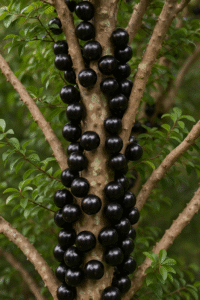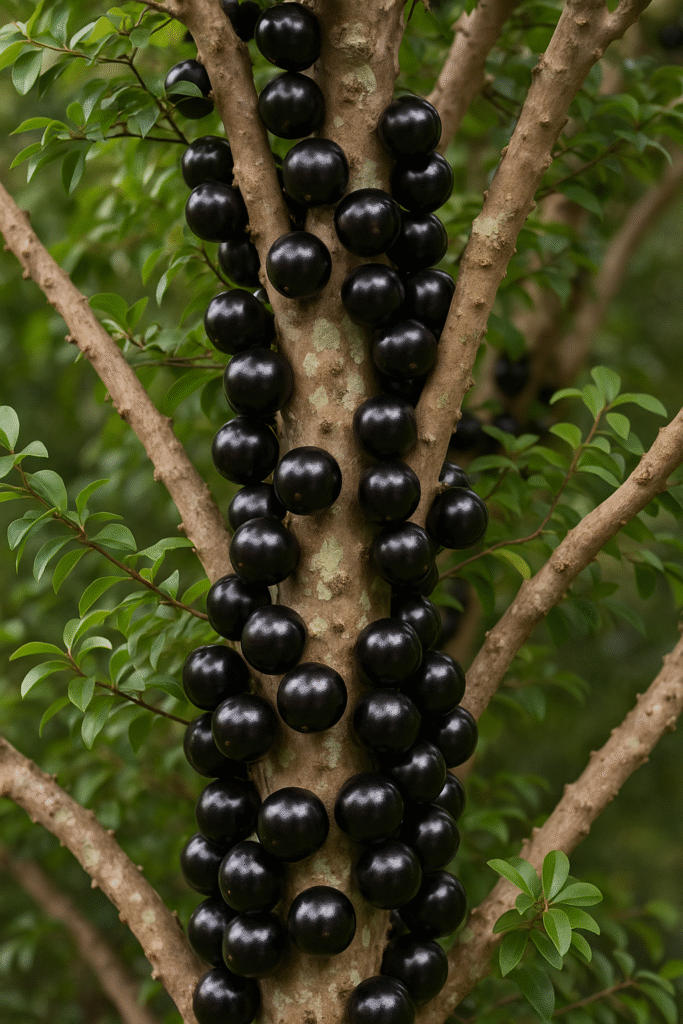Jabuticaba is one of Brazil’s most iconic fruits. With its glossy, deep-purple skin, sweet pulp, and the unique way it grows directly on the tree trunk, jabuticaba captures the attention of children, gardeners, and chefs alike. Native to the Atlantic Forest and especially common in southeastern and southern Brazil, this fruit has become a favorite not only for eating but also for cultivating in backyards and small orchards.
In this article, you’ll discover everything about this amazing fruit: its origins, characteristics, health benefits, curiosities, and tips for growing it successfully at home. And at the end, you’ll learn how a 4-in-1 digital soil tester can help you care for your jabuticaba tree with precision.
Origin and Meaning of the Name
The word jabuticaba comes from the Tupi-Guarani language: ïapotï’kaba, meaning “fruit in a bud on the wood.” It’s an accurate name, as jabuticabas grow directly on the trunk and thick branches in a phenomenon known as cauliflory—a rare trait among tropical fruits that makes the jabuticaba tree even more striking.
The tree belongs to the Plinia genus, part of the Myrtaceae family, which also includes guava and pitanga. Brazil is home to several native jabuticaba species, such as Plinia cauliflora, Plinia jaboticaba, and Plinia trunciflora.
Features of the Jabuticaba Tree
Jabuticaba trees grow slowly, but they’re extremely ornamental. When well-cared for, they can reach heights of 5 to 10 meters. Their smooth bark and small, glossy leaves are beautiful even when the tree is not fruiting. But during harvest season, the tree transforms into a breathtaking sight, with hundreds of dark berries clinging to the trunk like shiny black pearls.
The fruit itself is about 2 to 4 cm in diameter, with a thick, purple-black skin and sweet, white or pinkish pulp. Its flavor is mild and slightly tart—perfect for eating fresh or using in jellies, liqueurs, wines, and desserts.
Health Benefits of Jabuticaba
Beyond its delightful taste, jabuticaba is rich in antioxidants, especially anthocyanins, the pigments that give the fruit its dark color. These compounds help neutralize free radicals, reducing the risk of chronic diseases and premature aging.
Other health benefits include:
-
High fiber content – improves digestive health
-
Rich in vitamin C – boosts immunity
-
Anti-inflammatory effects – helps prevent chronic conditions
-
Low glycemic index – safe in moderation for diabetics
Most of the nutritional value is in the skin, so consuming the whole fruit or using the peel in juices and recipes is highly recommended.
How to Grow Jabuticaba: Soil, Water, and Light
Growing a jabuticaba tree at home is not only possible, it’s also rewarding. It can be cultivated directly in the ground or in large pots, as long as you follow some basic care guidelines:
1. Soil Requirements
Jabuticaba trees thrive in fertile, well-drained, slightly acidic soils, with a pH between 5.5 and 6.5. Avoid compacted or overly wet areas that can cause root rot.
2. Watering
Jabuticabas love consistent moisture, especially in their early growth stages. Water the tree 2 to 3 times a week, depending on your climate.
3. Sunlight
This plant requires full sun—at least 6 hours of direct light daily—to grow and produce fruit properly.
4. Fertilization
Use organic compost or NPK fertilizer (10-10-10 or 20-10-10) every 2 to 3 months, particularly during active growth and flowering.
5. Pruning
Prune gently at the end of winter to shape the canopy, improve airflow, and encourage fruiting.
Fruiting and Time to Maturity
Jabuticabas grown from seed may take 8 to 12 years to bear fruit, but grafted saplings can produce in just 3 to 5 years. Fruiting usually occurs in late summer to early autumn, and with proper irrigation, some trees may yield multiple harvests per year.
Can You Grow Jabuticaba in a Pot?
Yes! Jabuticaba grows well in large pots (at least 15 gallons or 60 liters) with good drainage. Potted trees need more attention to watering and feeding, but the reward is worth it. Be extra careful with soil moisture, as pots dry out faster than garden beds.
Fun Facts About Jabuticaba
-
Jabuticaba is a traditional ingredient in colonial Brazilian recipes, especially jellies and liqueurs.
-
The city of Sabará (Minas Gerais) holds an annual Jabuticaba Festival.
-
There are jabuticaba trees that are over 100 years old and still produce fruit.
-
Fresh jabuticabas are highly perishable and begin to ferment just a few days after harvest.

Final Tip: Monitor Your Jabuticaba Tree with Smart Tools
Caring for a jabuticaba tree means monitoring several environmental factors—soil moisture, pH, light levels, and temperature. Fortunately, modern tools make this easy, even for beginner gardeners.
🌿 We recommend the 4-in-1 Digital Soil Tester — a compact and easy-to-use device that measures:
-
✅ Soil moisture – avoid overwatering or drought stress
-
✅ pH levels – ensure your soil remains slightly acidic
-
✅ Light intensity – verify if your tree is getting enough sun
-
✅ Temperature – monitor ideal growing conditions
-
✅ Backlit LCD screen – for easy reading in all environments
This device is ideal for home gardening, potted plants, and small-scale agriculture. Whether you’re growing jabuticaba, herbs, or vegetables, it helps you make smart, informed decisions for healthier plants and better harvests.
🌿 Want to Discover Another Incredible Tropical Plant?
Learn all about Taioba — a leafy green that’s not only nutritious and beautiful, but also easy to grow at home. From planting tips to safety and recipes, this guide covers it all!

